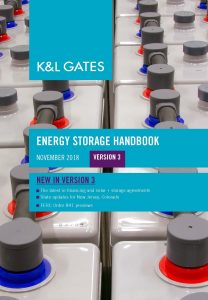By Abraham F. Johns, Toks A. Arowojolu, William M. Keyser, Eric E. Freedman, David P. Hattery, and Sandra E. Safro
On November 15, 2018, the Federal Energy Regulatory Commission (“FERC”) announced two major policy developments on the treatment of Accumulated Deferred Income Taxes (“ADIT”) in light of the recent reduction of the federal income tax rate in the Tax Cuts and Jobs Act of 2017. The proposed developments are intended to benefit utility customers by providing for a fair return of the tax savings created by the new law. First, FERC issued a Policy Statement that outlines FERC’s policy on the treatment of ADIT for both accounting and ratemaking purposes for public utilities, natural gas pipelines and oil pipelines in light of the recent reduction in income taxes. Second, in a notice of proposed rulemaking (“NOPR”), FERC proposes to require all public utility transmission providers to revise their transmission rates to account for the reduction in income taxes caused by the Tax Cuts and Jobs Act of 2017.
Policy Statement: Treatment of ADIT in Light of the Tax Rate Reduction
The Policy Statement, titled “Accounting and Ratemaking Treatment of Accumulated Deferred Income Taxes and Treatment Following the Sale or Retirement of Assets,” provides guidance on two questions FERC posed in its March 15, 2018, Notice of Inquiry (“NOI”).
First, FERC provides details on the specific accounts that public utilities and natural gas pipelines should use to record amortization of excess and deficient ADIT. FERC also explains how oil pipelines should treat deferred tax balances and provides that, for ratemaking purposes, FERC will continue the practice of amortization and removal of excess or deficient ADIT by reducing the returned allowed prior to grossing up for income taxes.
Second, FERC provides guidance on how public utilities, natural gas pipelines and oil pipelines should address excess and/or deficient ADIT that is recorded on their books after December 31, 2017, as a result of the sale or retirement of assets. The Policy Statement explains that in the case of a public utility or natural gas pipeline that continues to have an income tax allowance, any excess or deficient ADIT associated with an asset must continue to be amortized in rates even after the sale or retirement of that asset. If the rate treatment of the excess or deficient ADIT is disallowed, then the amounts should be written off in the year of the disallowance. In line with the existing Uniform System of Accounting for oil pipelines, FERC notes that for accounting purposes an oil pipeline’s ADIT balance will be reduced immediately by the full amount of the excess or deficient tax reserve. For ratemaking purposes, an oil pipeline would maintain the excess or deficient ADIT in the ADIT account and would continue to amortize those amounts when determining its income tax allowance as part of the ratemaking process after the assets are sold or retired.
The Policy Statement also states that, to provide greater transparency, public utilities, natural gas pipelines and oil pipelines should provide additional information regarding ADIT in their annual financial filings.
NOPR: Closing the Gap in Transmission Formula Rates of Public Utilities
The proposed reforms are intended to ensure ratepayers receive the benefits of the Tax Cuts and Jobs Act of 2017 and that transmission rates are just and reasonable following the enactment of the Tax Cuts and Jobs Act. As explained in the NOPR, the proposed changes fall into three categories and apply differently to transmission formula rates and stated rates. First, the NOPR proposes to require public utilities with formula rates to include a mechanism in their formula rate to deduct excess ADIT from or add deficient ADIT to their rate bases. Second, the NOPR proposes to require public utilities with transmission formula rates to include a mechanism in the formula rate that decreases or increases their income tax allowances by any amortized excess or deficient ADIT. The NOPR proposes to require that public utility transmission providers with stated rates to determine the excess or deficient ADIT caused by the Tax Cuts and Jobs Act based on the ADIT amounts approved in their last rate case and return or recover this amount from ratepayers. Finally, the NOPR proposes to require all public utility transmission providers with transmission formula rates to include a new permanent worksheet into their transmission formula rate that will track information annually related to excess or deficient ADIT.
In his remarks at FERC’s monthly meeting, Chairman Chatterjee emphasized that the NOPR does not prescribe a one-size-fits-all approach to make the required adjustments. Rather, the NOPR recognizes that multiple approaches to modify rate base may be just and reasonable.
All three Commissioners strongly supported the NOPR. Commissioner LaFleur stated, “My goal is to get tax savings back into the hands of the customers as quickly as possible. That’s not yet done, but this is an important first step.”
Comments are due within 30 days of publication of the NOPR in the Federal Register. We will continue to monitor the developments of this proceeding.


